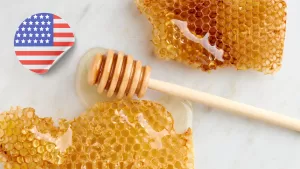Canada is home to a rich tapestry of landscapes and climates, each contributing to the unique flavors and types of honey produced across the country. From the prairies of Alberta to the forests of British Columbia, Canadian honey reflects the diverse flora that bees visit. In this blog, we will delve into the different types of Canadian honey, their distinct flavors, and the factors that influence their production. We will also explore the health benefits and culinary uses of honey, highlighting why Canadian honey is a treasure worth savoring.
Table of Contents
ToggleThe Art of Beekeeping in Canada
Before exploring the various types of honey produced in Canada, it’s important to understand the art of beekeeping in this vast country. Beekeeping is a thriving industry, with over 8,000 registered beekeepers managing approximately 700,000 colonies nationwide. The diverse geography and climate across Canada support a wide range of flowering plants, providing bees with ample foraging opportunities.
Canadian beekeepers employ sustainable practices to ensure the health of their colonies and the quality of their honey. Many beekeepers are committed to organic practices, avoiding pesticides and chemicals that can harm both bees and the environment. This dedication to sustainable beekeeping not only supports bee populations but also results in high-quality honey that reflects the local ecosystem.
Types of Canadian Honey
Clover Honey
Clover honey is one of the most popular and widely produced types of honey in Canada. Its light color and mild flavor make it a favorite among consumers. Clover flowers are abundant across Canada, particularly in the prairie provinces of Alberta and Saskatchewan, making it an easily accessible nectar source for bees.
The flavor profile of clover honey is sweet and subtle, making it a versatile choice for sweetening tea, drizzling over pancakes, or adding to baking recipes. Clover honey is also known for its numerous health benefits, including antioxidant properties and potential relief for allergies.
Wildflower Honey
Wildflower honey is produced from the nectar of various wildflowers, resulting in a complex and diverse flavor profile. This type of honey varies significantly depending on the season and location, as bees forage on whatever flowers are in bloom. As a result, wildflower honey can range from light to dark in color and possess a range of flavors, from fruity to floral.
Regions like British Columbia and Ontario are known for their wildflower honey production, where bees access a wide variety of nectar sources. This honey is perfect for those who enjoy a more robust and unique taste. Additionally, wildflower honey is rich in vitamins and minerals, making it a nutritious choice.
Buckwheat Honey
Buckwheat honey is a dark, bold honey that is distinctively rich in flavor. It is produced from the nectar of buckwheat flowers, which thrive in the cooler climates of Canada. This honey is known for its strong, malty taste and dark color, often making it a favorite among those who prefer a more intense honey flavor.
Buckwheat honey is particularly high in antioxidants and has been praised for its potential health benefits, including wound healing and cough relief. Its robust flavor pairs well with hearty foods, making it an excellent choice for marinades, dressings, or even as a glaze for meats.
Heather Honey
Heather honey is a rare and sought-after variety in Canada, known for its distinct flavor and aroma. Produced from the nectar of heather plants, which bloom in the late summer months, this honey has a unique floral taste and a dark amber color. The production of heather honey is particularly prominent in regions like Newfoundland and parts of British Columbia.
The flavor of heather honey is often described as aromatic and slightly herbal, making it a delightful addition to cheeses or served alongside charcuterie boards. Its distinct taste and limited availability contribute to its higher price point, but it is a true delicacy for honey enthusiasts.
Maple Honey
Maple honey, also known as maple syrup honey, is a unique fusion of flavors that combines the sweetness of honey with the rich, earthy notes of maple syrup. Produced in regions where maple trees thrive, this honey is created when bees forage on the blossoms of maple trees.
This type of honey has a distinct flavor profile that is both sweet and slightly caramel-like. It is perfect for drizzling over pancakes, adding to baked goods, or using as a sweetener in beverages. Maple honey also boasts health benefits, including anti-inflammatory properties and antioxidants, making it a nutritious choice.
Orange Blossom Honey
Orange blossom honey is a fragrant and aromatic variety produced from the nectar of orange tree blossoms. While primarily associated with warmer climates, some Canadian beekeepers cultivate orange trees in greenhouses, allowing them to produce this delightful honey.
This honey is characterized by its light color and citrusy flavor, making it a refreshing addition to teas and salads. Orange blossom honey is also known for its potential health benefits, including its ability to aid digestion and boost the immune system.
Health Benefits of Canadian Honey
Honey is not only a delicious natural sweetener but also offers numerous health benefits. Canadian honey, in particular, is rich in antioxidants, vitamins, and minerals. Some of the key health benefits include:
- Antioxidant Properties: Honey contains antioxidants that help combat oxidative stress and reduce the risk of chronic diseases.
- Soothing Coughs and Sore Throats: Honey has natural soothing properties and can be effective in alleviating coughs and sore throats.
- Wound Healing: The antimicrobial properties of honey make it effective for wound healing and skin care. Applying honey topically can help speed up the healing process.
- Digestive Health: Consuming honey may support digestive health by promoting the growth of good bacteria in the gut.
- Energy Boost: Honey is a natural source of carbohydrates, making it an excellent energy booster for athletes and active individuals.
Culinary Uses of Canadian Honey
Canadian honey is a versatile ingredient that can be used in various culinary applications. Here are some popular ways to incorporate honey into your cooking:
- Baking: Honey can be used as a natural sweetener in cakes, cookies, and bread. It adds moisture and enhances flavor.
- Dressings and Marinades: Incorporate honey into salad dressings or marinades for a touch of sweetness and flavor complexity.
- Tea and Beverages: Use honey to sweeten your favorite hot or cold beverages. Its natural flavors can enhance the overall taste.
- Cheese Pairings: Drizzle honey over cheese platters to complement the flavors of various cheeses. It pairs exceptionally well with aged cheeses.
- Glazes: Use honey as a glaze for roasted meats, vegetables, or fruits to add a delightful caramelization and sweetness.
Supporting Local Beekeepers
When purchasing honey, consider supporting local beekeepers and honey producers. Local honey not only promotes sustainable practices but also ensures that you receive the freshest and highest quality honey. Many Canadian beekeepers offer farm tours, honey tastings, and educational workshops, providing an opportunity to learn more about the importance of bees in our ecosystem.
Buying local honey also helps preserve the diversity of bee species and encourages the growth of regional flora. By supporting local beekeepers, you are contributing to the health of the environment and the sustainability of honey production in Canada.
The Importance of Bees in the Ecosystem
Bees play a crucial role in maintaining ecological balance. As pollinators, they contribute to the reproduction of a wide variety of plants, ensuring food production for both wildlife and humans. The decline in bee populations poses a significant threat to global food security and biodiversity.
By supporting sustainable beekeeping practices and advocating for bee-friendly environments, we can help protect these vital pollinators and ensure their survival. This, in turn, will help secure the future of honey production and the diverse flavors that Canadian honey has to offer.
Conclusion
Canada is home to a stunning variety of honey types, each with its unique flavors and characteristics. From the delicate sweetness of clover honey to the bold richness of buckwheat honey, the diversity of Canadian honey reflects the rich landscapes and climates of the country. As we explore the different types of honey, it’s essential to appreciate the artistry of beekeeping and the critical role that bees play in our ecosystem.
Whether you’re a honey enthusiast or new to the world of honey, there’s a type of Canadian honey for everyone to enjoy. Incorporate honey into your culinary creations, savor its health benefits, and support local beekeepers to ensure that these remarkable insects continue to thrive. Embrace the sweetness of Canadian honey and discover the rich flavors that nature has to offer.



